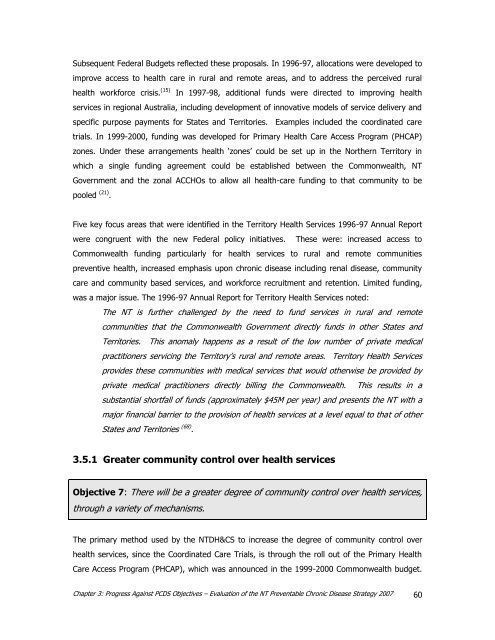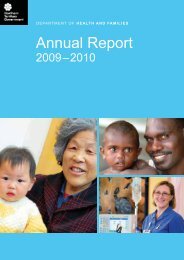PCD Strategy Evaluation 2007.pdf - NT Health Digital Library ...
PCD Strategy Evaluation 2007.pdf - NT Health Digital Library ...
PCD Strategy Evaluation 2007.pdf - NT Health Digital Library ...
You also want an ePaper? Increase the reach of your titles
YUMPU automatically turns print PDFs into web optimized ePapers that Google loves.
Subsequent Federal Budgets reflected these proposals. In 1996-97, allocations were developed toimprove access to health care in rural and remote areas, and to address the perceived ruralhealth workforce crisis. (15) In 1997-98, additional funds were directed to improving healthservices in regional Australia, including development of innovative models of service delivery andspecific purpose payments for States and Territories. Examples included the coordinated caretrials. In 1999-2000, funding was developed for Primary <strong>Health</strong> Care Access Program (PHCAP)zones. Under these arrangements health „zones‟ could be set up in the Northern Territory inwhich a single funding agreement could be established between the Commonwealth, <strong>NT</strong>Government and the zonal ACCHOs to allow all health-care funding to that community to bepooled (21) .Five key focus areas that were identified in the Territory <strong>Health</strong> Services 1996-97 Annual Reportwere congruent with the new Federal policy initiatives. These were: increased access toCommonwealth funding particularly for health services to rural and remote communitiespreventive health, increased emphasis upon chronic disease including renal disease, communitycare and community based services, and workforce recruitment and retention. Limited funding,was a major issue. The 1996-97 Annual Report for Territory <strong>Health</strong> Services noted:The <strong>NT</strong> is further challenged by the need to fund services in rural and remotecommunities that the Commonwealth Government directly funds in other States andTerritories. This anomaly happens as a result of the low number of private medicalpractitioners servicing the Territory‟s rural and remote areas. Territory <strong>Health</strong> Servicesprovides these communities with medical services that would otherwise be provided byprivate medical practitioners directly billing the Commonwealth. This results in asubstantial shortfall of funds (approximately $45M per year) and presents the <strong>NT</strong> with amajor financial barrier to the provision of health services at a level equal to that of otherStates and Territories (68) .3.5.1 Greater community control over health servicesObjective 7: There will be a greater degree of community control over health services,through a variety of mechanisms.The primary method used by the <strong>NT</strong>DH&CS to increase the degree of community control overhealth services, since the Coordinated Care Trials, is through the roll out of the Primary <strong>Health</strong>Care Access Program (PHCAP), which was announced in the 1999-2000 Commonwealth budget.Chapter 3: Progress Against <strong>PCD</strong>S Objectives – <strong>Evaluation</strong> of the <strong>NT</strong> Preventable Chronic Disease <strong>Strategy</strong> 2007 60
















